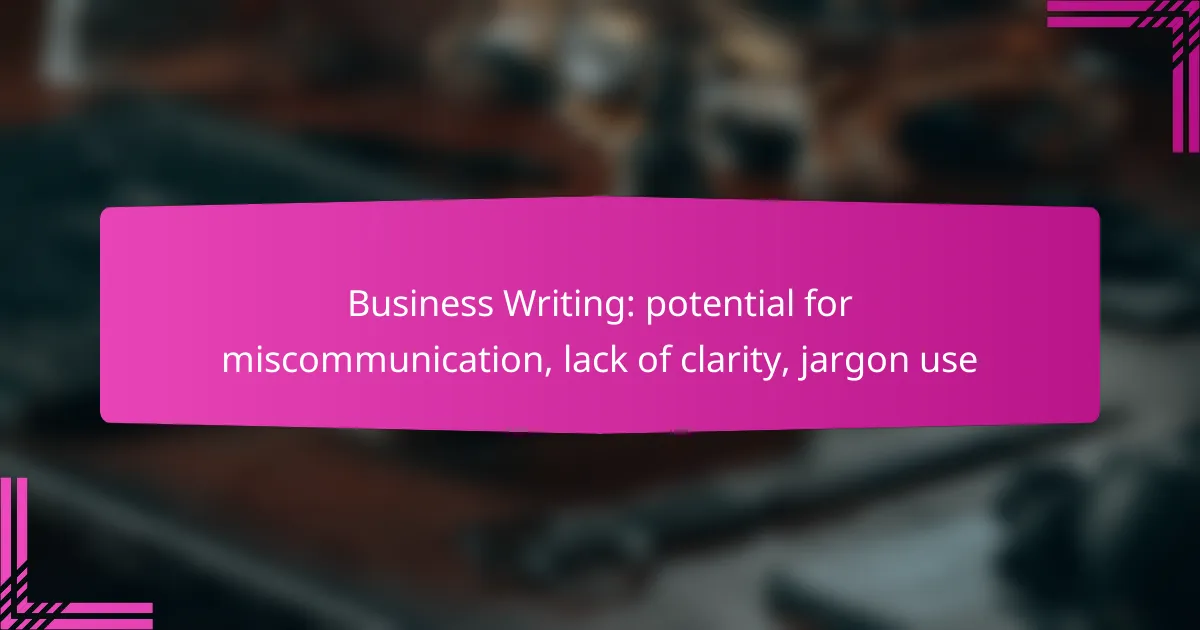Effective business writing is crucial for clear communication and collaboration. Miscommunication often arises from a lack of clarity, complex language, and the overuse of jargon, which can alienate those unfamiliar with specialized terms. By prioritizing straightforward language and providing context, businesses can enhance understanding and reduce the risk of errors.

How can miscommunication in business writing be resolved?
Miscommunication in business writing can be resolved through clear language, active voice, feedback mechanisms, training programs, and standardized templates. These strategies help ensure that messages are understood as intended, reducing the risk of confusion and errors.
Clear and concise language
Using clear and concise language is essential for effective business communication. Avoid jargon and overly complex terms that may confuse the reader. Instead, aim for straightforward vocabulary that conveys your message directly.
For instance, instead of saying “utilize,” simply use “use.” Keeping sentences short and to the point can significantly enhance clarity.
Active voice usage
Active voice makes writing more direct and engaging, which helps prevent miscommunication. In active voice, the subject performs the action, making it clear who is responsible for what. For example, “The manager approved the budget” is clearer than “The budget was approved by the manager.”
Using active voice can also make your writing more persuasive and easier to understand, encouraging quicker decision-making.
Feedback mechanisms
Implementing feedback mechanisms allows for clarification and improvement in business writing. Encourage readers to ask questions or provide input on written communications. This two-way interaction can highlight areas of confusion and lead to better understanding.
Consider using surveys or follow-up meetings to gather feedback on important documents. This practice can help identify recurring issues and refine future communications.
Training programs
Establishing training programs focused on effective writing skills can significantly reduce miscommunication. These programs should cover best practices in clarity, tone, and structure, tailored to the specific needs of the organization.
Regular workshops or online courses can keep employees updated on effective communication strategies, fostering a culture of clarity within the workplace.
Standardized templates
Standardized templates can streamline business writing and reduce miscommunication. By providing a consistent format for documents, emails, and reports, employees can focus on content rather than structure.
Templates should include essential elements such as headings, bullet points, and clear sections. This consistency helps ensure that important information is not overlooked and is presented in an easily digestible format.

What are the common causes of lack of clarity in business writing?
Lack of clarity in business writing often stems from complex sentence structures, ambiguous terminology, overuse of jargon, and insufficient context. These factors can lead to miscommunication and misunderstandings, hindering effective collaboration and decision-making.
Complex sentence structures
Complex sentence structures can confuse readers and obscure the main message. Long sentences with multiple clauses may require more effort to understand, leading to misinterpretation. Aim for clarity by using shorter, simpler sentences that convey one idea at a time.
For example, instead of saying, “The team, which has been working diligently on the project, will present their findings at the meeting next week,” you could say, “The team will present their findings at next week’s meeting.” This reduces complexity and enhances understanding.
Ambiguous terminology
Ambiguous terminology can create confusion, as words may have different meanings in various contexts. Using terms that are not universally understood can lead to miscommunication among team members or stakeholders. Always define key terms when they are first introduced.
For instance, the word “stakeholder” can refer to anyone from investors to employees. Clarifying who you mean by “stakeholder” in a specific context can prevent misunderstandings and ensure everyone is on the same page.
Overuse of jargon
Overuse of jargon can alienate readers who are not familiar with specific industry terms. While jargon can be useful among experts, it can hinder communication with broader audiences. Limit jargon use and opt for plain language whenever possible.
For example, instead of saying, “We need to leverage our synergies to optimize our deliverables,” you could say, “We need to work together to improve our results.” This makes your writing more accessible and clear.
Insufficient context
Insufficient context can leave readers guessing about the background or purpose of the information presented. Providing adequate context helps readers understand the significance of your message and how it relates to their work. Always include relevant details that frame your main points.
For instance, if you mention a new policy, briefly explain its purpose and implications. This could be as simple as stating, “The new policy aims to improve customer satisfaction by streamlining our response times.” This gives readers a clear understanding of why the information matters.

How does jargon use affect business communication?
Jargon can significantly hinder business communication by creating barriers between experts and non-experts. It often leads to confusion, misinterpretation, and disengagement among team members and clients who may not be familiar with specialized terms.
Excludes non-experts
Using jargon can alienate individuals who lack specific industry knowledge. When communication is filled with technical terms, those outside the field may feel excluded or intimidated, which can stifle collaboration and input from diverse perspectives.
For example, a marketing team discussing “SEO optimization” without explaining the concept may leave non-marketing colleagues unsure about the conversation. This exclusion can lead to a lack of participation in discussions and decision-making processes.
Creates misunderstandings
Jargon can lead to misunderstandings, as terms may have different meanings in various contexts. When team members interpret jargon differently, it can result in misaligned goals and confusion about project requirements.
Consider a scenario where a project manager uses the term “leverage” without clarification. Some team members might interpret it as using resources effectively, while others may think it refers to financial leverage. Such discrepancies can derail projects and lead to costly errors.
Reduces engagement
When communication is laden with jargon, it can reduce engagement among team members and clients. People are less likely to participate in discussions if they feel they do not understand the language being used.
To foster a more inclusive environment, businesses should strive to simplify language and explain necessary jargon when it must be used. This approach encourages participation and ensures that everyone feels valued and understood, ultimately enhancing teamwork and productivity.

What frameworks can improve business writing clarity?
To enhance clarity in business writing, frameworks such as plain language guidelines and audience analysis techniques are essential. These approaches help eliminate jargon, reduce miscommunication, and ensure the message resonates with the intended audience.
Plain language guidelines
Plain language guidelines focus on using straightforward vocabulary and sentence structures to convey ideas clearly. This means avoiding complex words and jargon that may confuse readers. For example, instead of saying “utilize,” simply use “use.”
Key principles include using short sentences, active voice, and familiar terms. Aim for a reading level that matches your audience’s comprehension abilities, typically around the 8th-grade level for general business communication. This approach can significantly reduce misunderstandings.
Audience analysis techniques
Audience analysis techniques involve understanding the characteristics, needs, and preferences of your target readers. This analysis helps tailor your writing to ensure it is relevant and engaging. Consider factors such as age, education level, and professional background when crafting your message.
To effectively analyze your audience, create profiles or personas that represent different segments. Use surveys or feedback forms to gather insights about their preferences. This information allows you to adjust your tone, style, and content to better connect with your audience, ultimately improving clarity and reducing the potential for miscommunication.

What tools help enhance clarity in business writing?
Several tools can significantly improve clarity in business writing by addressing grammar, readability, and word choice. Utilizing these resources can help avoid miscommunication and ensure your message is conveyed effectively.
Grammarly for grammar checks
Grammarly is a widely used tool that checks for grammatical errors, punctuation mistakes, and stylistic issues in your writing. It provides real-time suggestions, allowing you to correct errors as you write, which can enhance clarity and professionalism.
When using Grammarly, pay attention to the context-specific suggestions it offers. For example, it may recommend changing passive voice constructions to active voice for stronger statements. Regularly reviewing these suggestions can help you develop better writing habits over time.
Hemingway Editor for readability
The Hemingway Editor focuses on improving the readability of your text by highlighting complex sentences and passive voice. It assigns a readability score, suggesting adjustments to make your writing more concise and direct.
To use Hemingway effectively, aim for a score that indicates your writing is easily understandable by a broad audience. Shorter sentences and simpler words can help achieve this. For instance, instead of saying “utilize,” consider using “use” for clearer communication.
Thesaurus for word choice
A thesaurus is a valuable tool for enhancing word choice in business writing. It helps you find synonyms that can make your writing more engaging and precise. However, it’s essential to choose words that fit the context and tone of your message.
When selecting synonyms, consider the connotations and nuances of each word. For example, instead of using “assist,” you might choose “help” for a more straightforward approach. Avoid jargon unless it is commonly understood in your industry, as this can lead to confusion.



